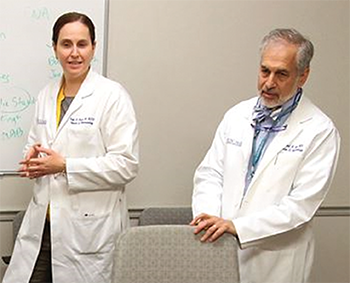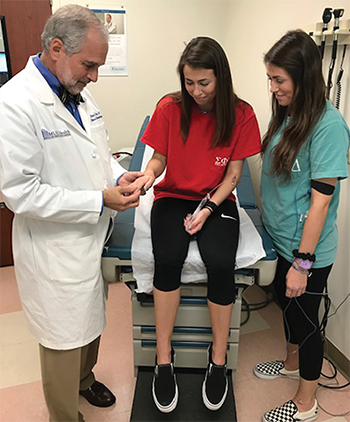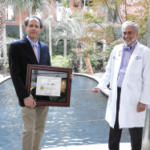
Dr. Silver and Dr. Hant, MUSC Fellowship Program Director, conduct a didactic session for fellows.
The Division of Rheumatology and Immunology at the Medical University of South Carolina (MUSC), Charleston, was formally established in 1974 by its first division chief, E. Carwile LeRoy, MD. Twenty-one years later, when Richard M. Silver, MD, assumed leadership, the division had acquired international renown for its scleroderma research. Now, having just retired as division chief, Dr. Silver says that’s a reputation he is “proud to say still exists.” It’s safe to say, in fact, that the division’s national and international reputation for clinical and research innovation has grown exponentially.
During Dr. Silver’s tenure, there was significant growth in the number of faculty members employed, in its clinical reach, and in research funding and innovation. Dr. Silver accomplished these goals by focusing on the essential prongs of recruiting excellent researchers, growing the research funding base and fostering outreach to diverse patient populations.
Career Path
A professor of medicine and pediatrics, Dr. Silver was named Distinguished University Professor at MUSC in 2007. His own research, focusing on scleroderma, has advanced knowledge of scleroderma lung disease. For example, he and his colleagues were the first to use bronchoalveolar lavage to characterize scleroderma lung disease.
He credits his growth as an expert in academic rheumatology to his exposure to several esteemed mentors: Nortin Hadler, MD, at the University of North Carolina, Chapel Hill, one of his first attendings; the late Barbara Ansell, MD, a pediatric rheumatologist at Taplow and the Northwick Park Hospital in London, with whom he spent nine months learning about juvenile idiopathic arthritis; and the late Nathan Zvaifler, MD, his division chief and mentor during a fellowship at the University of California, San Diego (UCSD), who introduced him to immunology and bench research and who taught him “to probe and question the dogma in our field.”
During Dr. Silver’s tenure, there was significant growth in the number of faculty members employed, in its clinical reach, & in research funding & innovation.
Dr. Silver says the late Dr. LeRoy, who hired Dr. Silver as a faculty member at MUSC in 1981, was another of his mentors. “Dr. LeRoy was one of the giants in the field of scleroderma, and he allowed me to develop my own footprint and expertise in scleroderma and fibrosis research.”
Key Recruitments

Twin sisters Kaylee and Haylee Thomas, now sophomores in college, have been followed by Dr. Silver since age 7.
Early in his leadership, Dr. Silver recognized that MUSC’s location afforded the division an opportunity to study rheumatic disease disparities, especially in scleroderma and lupus. African-Americans—in particular the Gullah, who reside in the low country of the Carolinas and Georgia and are descendants of enslaved Africans whose roots can be traced to Sierra Leone in West Africa—have a high prevalence of connective tissue diseases and disproportionately worse outcomes. Dr. Silver wanted to build a lupus center, so he recruited Gary Gilkeson, MD, an authority in lupus, from Duke University, in 1996. Following Dr. Silver’s initial stint as principal investigator for a Multidisciplinary Clinical Research Center grant from the National Institutes of Health, Dr. Gilkeson became the principal investigator for two subsequent grants, including a current Core Center for Clinical Research P30 grant funded by the National Institute of Arthritis and Musculoskeletal and Skin Diseases.
Dovetailing with an existing endocrinology community outreach program, Dr. Gilkeson increased outreach to the Gullah African-American community. That program now includes clinical environmental genetics to determine sources of the health disparities in that population.
Helping bolster research into the genetic aspects are Paula Ramos, PhD, and a recent recruit, Betty Tsao, PhD, from UCLA, who has assumed one of two newly endowed chairs.
In the interim, Dr. Silver continued to recruit others for the lupus team, including Tammy Nowling, PhD, Diane Kamen, MD, Melissa Cunningham, MD, PhD, and Eric Zollars, MD, PhD.
Another recruitment vital to the success of the division and its scleroderma research is that of Carol Feghali-Bostwick, PhD, who came from the University of Pittsburgh to claim the other endowed chair as co-director with Dr. Silver of the Scleroderma Center.
When Dr. Gilkeson joined the faculty in 1996, he brought along his fellow James Oates, MD, to the division. Dr. Oates recalls, “When I first met Dr. Silver, I knew I was in the right place. It was clear that his philosophy for physician-scientists was the same as mine: You need protected time and support. And that shows in the way he has run the division all along.”
As it turns out, the double recruitment has more than paid off: After a national search, Dr. Oates has now become the division chief.



